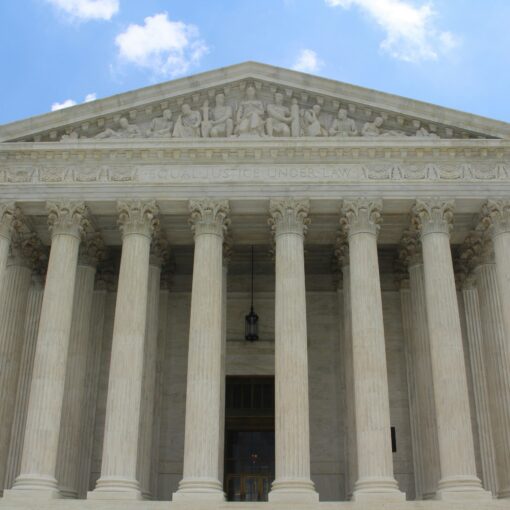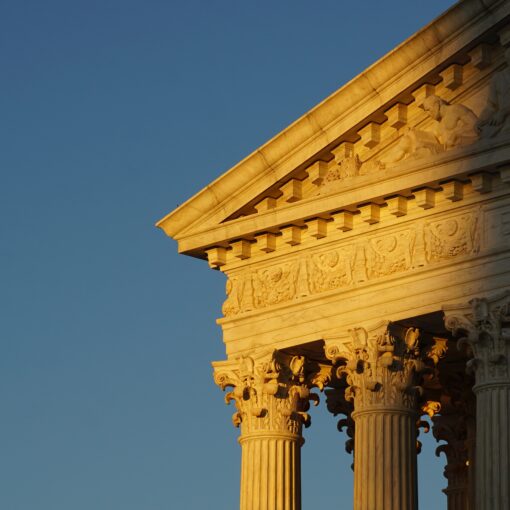By Julia Ciardullo
Fellow
On March 11, 2011, the plaintiff-appellees in American Electric Power Co. Inc., et al., v. Connecticut, et al. (No. 10-174) – six states,[1] the City of New York, and three land trusts[2] – filed their opposing briefs with the United States Supreme Court (the “Court”). In a prior post, we compared the briefs filed by the defendant-appellant electric utility companies.[3] This post analyzes the arguments made in the briefs filed by the states and the City of New York (collectively, the “States”) and the land trusts (together with the States, “Respondents”).
Respondents argue that they have standing; their claims arise under federal common law; and their claims do not raise nonjusticiable political questions. In addition, Respondents contend that their claims are not displaced by the Clean Air Act (“CAA”) or EPA’s newly-finalized greenhouse gas (“GHG”) regulations because neither impose limitations on the GHGs emitted from defendants’ power plants. However, Respondents acknowledge that EPA has entered into a settlement agreement that requires it to consider imposing such limitations, and concede that if it should do so, their claims would be displaced. Respondents’ arguments are summarized below.
Standing
The States argue that, based on Massachusetts v. EPA,[4] they have alleged all three of the requirements of Article III standing set forth in Lujan v. Defenders of Wildlife[5] (injury, causation, and redressability) and that the presence of one party with standing satisfies the Article III requirement for all parties.[6]
In particular, the States argue that:
(1) They have alleged injuries to their sovereign and proprietary interests, as well as injuries to the health and welfare of their citizens. These are the same injuries the Court held cognizable in Massachusetts v. EPA.
(2) Based on Massachusetts v. EPA, causation may be satisfied by showing that the defendants’ emissions make a “meaningful contribution” to the alleged injuries. Respondents allege that in 2004, defendants were responsible for emitting 650 million tons of carbon dioxide each year – 10 percent of the country’s emissions that year.
(3) Based on Massachusetts v. EPA, a lawsuit need not completely redress all of a plaintiff’s injuries at once; it is enough for standing if a favorable ruling would reduce the degree or likelihood of the injuries.
The States also contend that the Court’s discussion of Article III standing in Massachusetts v. EPA was not limited to statutory claims (a point made by Petitioners in distinguishing Massachusetts v. EPA from this case), and that the Court relied on Georgia v. Tenn. Copper Co.,[7] a common law nuisance case, for the proposition that “states are not normal litigants for purposes of invoking federal jurisdiction.”
The States further argue that their standing in this case is even more firmly established than in Massachusetts v. EPA for three reasons:
(1) Massachusetts v. EPA involved a petition for review of agency action and was therefore decided under summary judgment standards. As a result, the petitioners had to present evidence to establish the specific facts supporting standing. This case, however, is in the motion to dismiss stage, which means that general allegations of harm suffice.
(2) The chain of causation is shorter in this case because the States are seeking judicial relief directly from the entities responsible for the allegedly unlawful emissions. In contrast, the states in Massachusetts v. EPA sought judicial relief indirectly, by bringing a lawsuit against the regulatory agency.
(3) This case involves only common law claims (unlike Massachusetts v. EPA, which involved statutory claims), and thus the separation of powers concerns that ultimately drove the standing doctrine are not present.
With respect to prudential standing, the States argue that the generalized grievance doctrine raised by the utility companies is part of Article III, not prudential, standing, and in any event, they have shown concrete and particularized injuries, not generalized grievances.
Federal Common Law
Respondents argue that there is a well-established federal common law public nuisance cause of action for interstate air and water pollution claims. As a result, the Court not need create a new cause of action, as Petitioners suggest.
In addition, Respondents contend that their claims fall squarely within the federal common law of public nuisance. Respondents rebut Petitioners’ contentions that the federal common law of public nuisance is limited to localized problems that affect discrete areas and are traceable to discrete sources, and that recognizing their claims will open the floodgates to federal public nuisance litigation and increase the likelihood of inconsistent judicial remedies. In fact, Respondents point out that the consequence of not applying federal common law is that state common law could apply, which could result in far more inconsistent judicial remedies.
Political Question Doctrine/Non-Justiciability
Respondents argue that the political question doctrine does not bar adjudication of their claims for two reasons:
(1) The political question doctrine is limited to foreign affairs and constitutional issues (i.e., cases implicating separation of powers concerns), which are not present in this case.
(2) Contrary to the utility companies’ contentions, the adjudication of Respondents’ claims would not require an impermissible “initial policy determination” made in the absence of “judicially discoverable and manageable standards.” In fact, because public nuisance law is a settled part of the common law created by the judiciary, the standards that govern it were necessarily judicially discovered and any policy determinations that it requires are necessarily of a kind for judicial discretion.
Displacement
Most notably, Respondents argue that their common law nuisance claims are not yet displaced by either the CAA (as Petitioners suggest) or EPA’s newly-finalized GHG regulations (as TVA suggests) because neither impose limitations on the GHGs emitted from existing power plants – the power plants at issue in this case. However, Respondents concede that should EPA impose such limitations, their claims would be displaced.
Specifically, Respondents argue that the CAA does not displace their claims because it does not itself impose limitations on the emission of air pollutants; rather, it requires EPA to promulgate regulations doing so. Thus, displacement would only occur once EPA exercised its authority under the CAA to regulate GHG emissions from defendants’ power plants.
In addition, Respondents contend that because EPA’s newly-finalized GHG regulations only apply to motor vehicles and to new or substantially modified power plants – not to existing power plants – those regulations also do not displace their claims.
Nonetheless, Respondents acknowledge that EPA recently entered into a settlement agreement that requires it to complete a rulemaking by May 2012 on whether to impose limitations on GHG emissions from existing power plants. Should EPA impose such limitations, Respondents agree that their federal common law claims would then be displaced.
However, Respondents contend that a finding of displacement by the Court would be premature for a number of reasons:
(1) EPA retains discretion under the settlement agreement not to issue GHG emissions limitations on existing power plants.
(2) A number of cases have been filed challenging EPA’s GHG regulations, which are currently pending.
(3) Congress may defund EPA or prohibit EPA from regulating GHGs. In particular, the land trusts reference the recent appropriations bill (H.R. 1) that passed the House of Representatives on February 19, 2011 and the Senate Energy Tax Prevention Act of 2011 (H.R. 910), which would prohibit EPA from regulating GHGs from power plants and other stationary sources under the CAA. (H.R. 910 passed the House Energy and Commerce Committee on March 15, 2011, after the Respondents’ briefs were filed).
Respondents ask the Court to affirm the judgment of the Second Circuit Court of Appeals, which would remand the case to the district court. The district court judge would then suspend proceedings until EPA finalizes GHG regulations for existing power plants. In the event that EPA exercises its discretion not to regulate GHGs from existing power plants or Congress blocks EPA from acting, Respondents could then proceed with their suit.
A copy of the State’s brief can be found here. The land trusts’ brief can be found here. Oral arguments are scheduled for April 19, 2011 and a decision is expected by the end of the Court’s term in June.
________________________________________________________________
[1] Connecticut, New York, California, Iowa, Rhode Island and Vermont. Two other states, New Jersey and Wisconsin, were also plaintiffs in the original lawsuit, but have since withdrawn from the case.
[2] Open Space Institute, Inc., Open Space Conservancy, Inc., and Audubon Society of New Hampshire.
[3] American Electric Power Co. Inc., American Electric Power Service Corp., Cinergy Corp., Southern Co. and Xcel Energy Inc. (collectively, “Petitioners”) and Tennessee Valley Authority (“TVA”).
[4] 549 U.S. 497 (2007).
[5] 504 U.S. 555 (1992).
[6] The land trusts similarly argue that once the Court determines that at least one of the States has standing, it need not consider the land trusts’ standing. As a result, this blog post does not discuss the land trusts’ standing.
[7] 206 U.S. 230 (1907).



